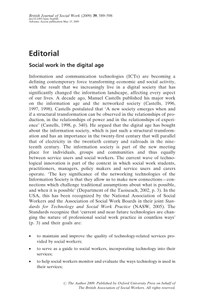Verslag van een kwalitatief onderzoek dat zich richt op de manier waarop gemeenten en UWV in de praktijk bezig zijn met het optimaliseren van de afstemming van de uitkeringsregimes van WW en Bijstand. De reis van de werkzoekende is daarbij centraal gesteld. Gekeken is in zes praktijken hoe activeringsregimes zijn vormgegeven en op welke momenten er sprake is van samenwerking. Gezocht is naar 'wat werkt' op lokaal/regionaal niveau en de focus lag op veelbelovende innoverende opvattingen, ideeën en uitvoering. Ook belemmeringen op beleid, organisatie en uitvoeringsniveau zijn in kaart gebracht.
DOCUMENT

In april '07 vond in de VS het congres 'Computers in Libraries' plaats. Gerard Bierens en Liesbeth Mantel signaleren de opvallendste trends. 'De bibliotheekcatalogus gaat onherroepelijk onder het mes.'
DOCUMENT

Deze publicatie geeft gerichte theoretische en praktische informatie ten behoeve van respectievelijk de gebruikers van de diverse machines en gereedschappen welke bij het omvormproces (dieptrekken, kraagtrekken, strekken, alsmede buigen en scheiden) worden gebruikt, geïnteresseerden in de betreffende processen, technische cursussen en opleidingen. De inhoud van deze publicatie behandelt de belangrijkste machines en gereedschappen, alsmede aanvullende informatie welke bij het vormgeven van dunne plaat van belang zijn. In de voorlichtingspublicaties VM 110 "Dieptrekken", VM 113 "Buigen" alsmede VM 114 "Scheiden" vindt u gegevens m.b.t. de diverse omvormprocessen en in VM 111 "Materialen" worden de hierbij gebruikte materialen behandeld. Deze voorlichtingspublicatie is een update van de in 2000 verschenen eerste druk, welke toentertijd is samengesteld door de werkgroep "Dieptrekken van dunne plaat, staal, aluminium". In het kader van een updateproject heeft het NIMR, inmiddels M2i (Materials innovation institute) geheten, geld ter beschikking gesteld om deze publicaties te vernieuwen en aan te passen aan de huidige stand der techniek.
DOCUMENT

VTB (Verbreding Techniek Basisonderwijs), het programma van het Platform Bèta Techniek dat zich richt op het primair onderwijs, is in 2004 een project gestart op de pabo gericht op de versterking van techniek. Het gaat ons in dit artikel vooral om de factoren die bijdroegen aan (eventueel) succes, de knelpunten, en uitdagingen voor verduurzaming. Hebben de projecten hun doelstellingen gerealiseerd? Zo ja: wat droeg dear wezenlijk aan bij? Zo nee: wat bleken de knelpunten te zijn? En: zijn we nu klaar met de invoering van wetenschap & techniek op de pabo of valt er nog wat te doen? Zijn er lessen te trekken wear (andere) pabo's hun voordeel mee kunnen doen?
DOCUMENT

Literatuur en psychologie hebben veel met elkaar te maken: net als in het echte leven lopen er in romans mensen rond die lets kunnen mankeren. Door romanpersonages te analyseren als echte personen kunnen er opmerkelijke conclusies getrokken worden. In dit artikel zal de figuur Elmer uit Gerard Reves novelle Werther Nieland gediagnostiseerd worden met behulp van het psychiatrisch model DSM-IV. Het zal blijken dat op Elmer de notie van de zogheten schizotypische persoonlijkheidsstoornis van toepassing is.
DOCUMENT

Er is wereldwijd een groeiende groep milieuvluchtelingen. Voor deze mensen, die vluchten als gevolg van bijvoorbeeld een tsunami, dijkdoorbraak, hoge concentraties vrijkomende giftige stoffen bij een industrieel ongeval, verwoestijning, uitputting van de bodem of langdurige regenval, bestaat nog geen adequaat internationaal beschermingsregime. Ons vorige artikel in Applied Research Today (april 2013) bracht in kaart welke soorten milieuvluchtelingen bestaan, en betoogde dat de bescherming van deze groep plaats kan vinden onder het VN-principe The Responsibility to Protect (R2P). R2P omvat onder andere een integrale aanpak die gericht is op het voorkomen, reageren en opbouwen, waarbij de verantwoordelijkheid is ondergebracht in drie pijlers: 1) een staat is zelf verantwoordelijk voor de bescherming van milieuvluchtelingen, 2) de internationale gemeenschap heeft een verantwoordelijkheid een staat hierbij te assisteren, en 3) de internationale gemeenschap heeft de verantwoordelijkheid om collectief snel en beslissend te reageren indien een staat zelf zijn milieuvluchtelingen niet kan of wil beschermen. Dit vervolgartikel formuleert hoe de integrale aanpak van The Responsibility to Protect kan worden geoperationaliseerd voor de bescherming van milieuvluchtelingen. ABSTRACT The number of environmental refugees is growing. An adequate international legal protection regime is lacking for people who, for example, flee as a result of a tsunami or levee breach; high concentrations of toxic substances from industrial accidents; desertification; soil depletion or prolonged rainfall. Our previous article in Applied Research Today (April 2013) described eight different groups of environmental refugees and argued that the protection of these groups can be ensured under the UN principle the Responsibility to Protect (R2P). R2P offers an integral approach that focuses on prevention, reaction and rebuilding. In first instance, the responsibility to take protective measures lies with the state itself. Secondly, the international community has a responsibility to assist. Lastly, when a state is not able or willing to protect its environmental refugees, the international community has the responsibility to respond in a swift and decisive manner. This follow-up article formulates how the Responsibility to Protect concept could be operationalised to protect environmental refugees.
DOCUMENT

De eerste uitgave van deze publicatie is in 1996 samengesteld door de werkgroep "Buigen van dunne plaat" en geeft gerichte theoretische en praktische informatie ten behoeve van respectievelijk de gebruikers van het buigproces, geïnteresseerden in dit proces, technische cursussen en opleidingen. In 2009 is deze publicatie aangepast aan de huidige stand der techniek. De inhoud van deze publicatie behandelt de aspecten welke voor het vormgeven van plaat door middel van buigen van belang zijn. De achterin toegevoegde supplementen over materialen en over machines en gereedschappen geven processpecifieke informatie over de desbetreffende onderwerpen. In de voorlichtingspublikaties VM 111 "Materialen" en VM 112 "Machines en gereedschappen" worden de algemene gegevens over deze onderwerpen behandeld.
DOCUMENT

In this chapter it is argued that self-direction is currently well above the head of the majority of youngsters and even of many adults. Evidence for this conclusion stems from developmental and brain research. However, for various reasons it is important that people develop the competences that are necessary for self-direction. To what degree is it possible to develop these competences? Are they 'learnable'? What can education contribute?
DOCUMENT

Inleiding op een themanummer van British Journal of Social Work over sociaal werk in de digitale samenleving.
DOCUMENT
